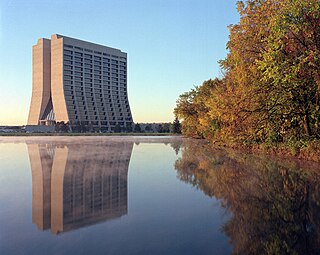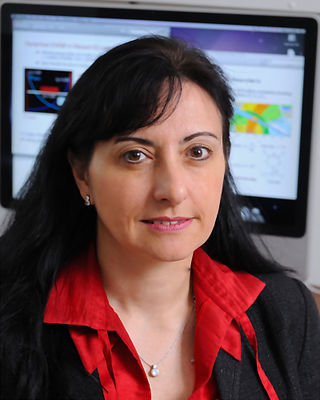
Leon Max Lederman was an American experimental physicist who received the Nobel Prize in Physics in 1988, along with Melvin Schwartz and Jack Steinberger, for research on neutrinos. He also received the Wolf Prize in Physics in 1982, along with Martin Lewis Perl, for research on quarks and leptons. Lederman was director emeritus of Fermi National Accelerator Laboratory (Fermilab) in Batavia, Illinois. He founded the Illinois Mathematics and Science Academy, in Aurora, Illinois in 1986, where he was resident scholar emeritus from 2012 until his death in 2018.

Particle physics or high-energy physics is the study of fundamental particles and forces that constitute matter and radiation. The field also studies combinations of elementary particles up to the scale of protons and neutrons, while the study of combination of protons and neutrons is called nuclear physics.

Fermi National Accelerator Laboratory (Fermilab), located in Batavia, Illinois, near Chicago, is a United States Department of Energy national laboratory specializing in high-energy particle physics.

The International Linear Collider (ILC) is a proposed linear particle accelerator. It is planned to have a collision energy of 500 GeV initially, with the possibility for a later upgrade to 1000 GeV (1 TeV). Although early proposed locations for the ILC were Japan, Europe (CERN) and the USA (Fermilab), the Kitakami highland in the Iwate prefecture of northern Japan has been the focus of ILC design efforts since 2013. The Japanese government is willing to contribute half of the costs, according to the coordinator of study for detectors at the ILC.

The Collider Detector at Fermilab (CDF) experimental collaboration studies high energy particle collisions from the Tevatron, the world's former highest-energy particle accelerator. The goal is to discover the identity and properties of the particles that make up the universe and to understand the forces and interactions between those particles.

The NOνA experiment is a particle physics experiment designed to detect neutrinos in Fermilab's NuMI beam. Intended to be the successor to MINOS, NOνA consists of two detectors, one at Fermilab, and one in northern Minnesota. Neutrinos from NuMI pass through 810 km of Earth to reach the far detector. NOνA's main goal is to observe the oscillation of muon neutrinos to electron neutrinos. The primary physics goals of NOvA are:
George Randolph Kalbfleisch was an American particle physicist.

QuarkNet is a long-term, research-based teacher professional development program in the United States jointly funded by the National Science Foundation and the US Department of Energy. Since 1999, QuarkNet has established centers at universities and national laboratories conducting research in particle physics across the United States, and have been bringing such physics to high school classrooms. QuarkNet programs are described in the National Research Council National Science Education Standards report (1995) and support the Next Generation Science Standards (2013).

Nigel Stuart Lockyer is a British-American experimental particle physicist. He is the current director of the Cornell Laboratory for Accelerator-based ScienceS and Education (CLASSE) as of May 1, 2023. He was the Director of the Fermi National Accelerator Laboratory (Fermilab), in Batavia, Illinois, the leading particle physics laboratory in the United States, from September 2013 to April 2022.

Marcela Silvia Carena Lopez is an Argentine theoretical physicist, and distinguished scientist at the Fermi National Accelerator Laboratory in Batavia, Illinois, where she is also head of the lab's Theory Division. She is also a professor at the University of Chicago, where she is a member of the Enrico Fermi Institute and the Kavli Institute for Cosmological Physics.
The Deep Underground Neutrino Experiment (DUNE) is a neutrino experiment under construction, with a near detector at Fermilab and a far detector at the Sanford Underground Research Facility that will observe neutrinos produced at Fermilab. An intense beam of trillions of neutrinos from the production facility at Fermilab will be sent over a distance of 1,300 kilometers (810 mi) with the goal of understanding the role of neutrinos in the universe. More than 1,000 collaborators work on the project. The experiment is designed for a 20-year period of data collection.

Mu2e, or the Muon-to-Electron Conversion Experiment, is a particle physics experiment at Fermilab in the US. The goal of the experiment is to identify physics beyond the Standard Model, namely, the conversion of muons to electrons without the emission of neutrinos, which occurs in a number of theoretical models. Former project co-spokesperson Jim Miller likens this process to neutrino oscillation, but for charged leptons. The rate for this process in the Standard Model of particle physics is unobservably small, so any observation of this process would constitute a major discovery and indicate new physics beyond the standard model. The experiment will be 10,000 times more sensitive than previous muon to electron conversion experiments, and probe effective energy scales up to 10,000 TeV.
Frederick Joseph Gilman is an American physicist and the Buhl Professor of Theoretical Physics Emeritus at Carnegie Mellon University.

Yaşar Önel is a Turkish-born physicist who holds Swiss and American citizenship. He received his Ph.D. in Physics from London University in 1975. He worked at the Queen Mary University of London in the United Kingdom, and Neuchatel and Geneva Universities in Switzerland before joining the University of Texas at Austin in 1986. Then, he moved to the University of Iowa in 1988. He is a tenured faculty professor. of Physics at the University of Iowa in Iowa City, IA, USA.
Janet Marie Conrad is an American experimental physicist, researcher, and professor at MIT studying elementary particle physics. Her work focuses on neutrino properties and the techniques for studying them. In recognition of her efforts, Conrad has been the recipient of several highly prestigious awards during her career, including an Alfred P. Sloan Research Fellow, a Guggenheim Fellow, and the American Physical Society Maria Goeppert-Mayer Award.

Herman Brenner White is an American physicist who works at Fermilab. He won the 2010 American Physical Society Edward A Bouchet Award.

Kevin T. Pitts is an American high energy particle physicist. In addition to his faculty appointment at the University of Illinois at Urbana–Champaign, in 2021 he was appointed chief research officer at Fermilab National Accelerator Laboratory. His research interests have included the CDF experiment and the Muon g-2 experiment at Fermilab.
Stéphane Willocq is an American physicist. He is a professor of physics at the University of Massachusetts Amherst and is involved in the upgrade of the muon trigger with MDT chambers for the high luminosity Large Hadron Collider.

Bonnie T. Fleming is an experimental particle physicist who has held leadership roles in several physics experiments and at Fermilab. Since 2022, she has been Fermilab's chief research officer and deputy director for science and technology. She has also served on the faculty of Yale University and the University of Chicago. Fleming is an expert in neutrino physics and liquid argon time projection chamber detector technology.
The Snowmass Process is a particle physics community planning exercise sponsored by the Division of Particles and Fields of the American Physical Society. During this process, scientists develop a collective vision for the next seven to ten years for particle physics research in the US.














